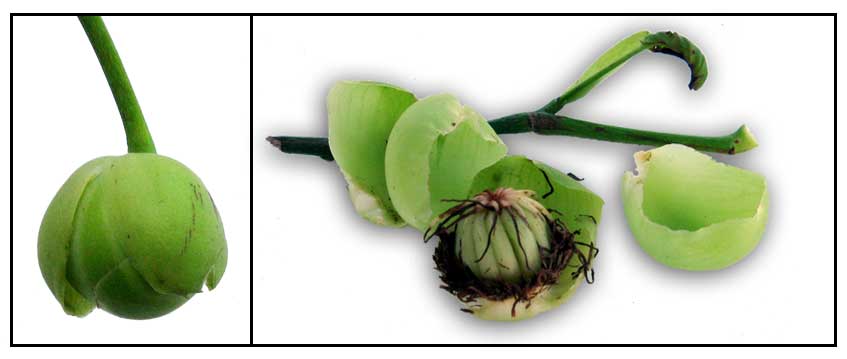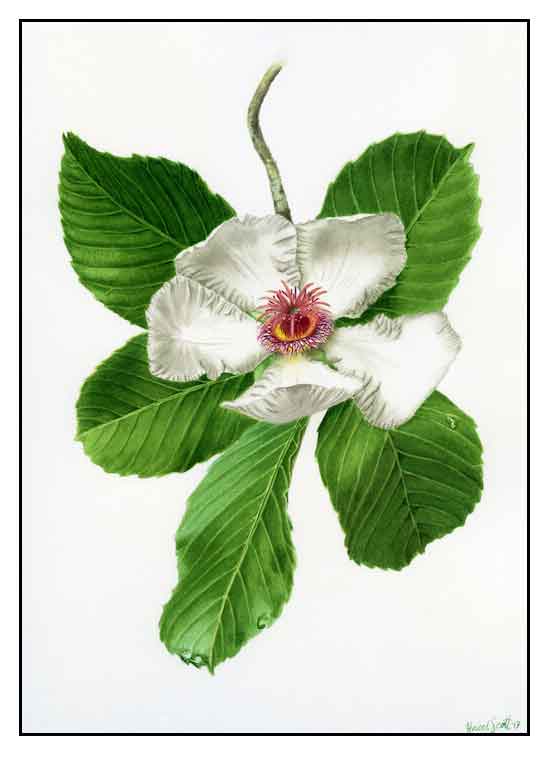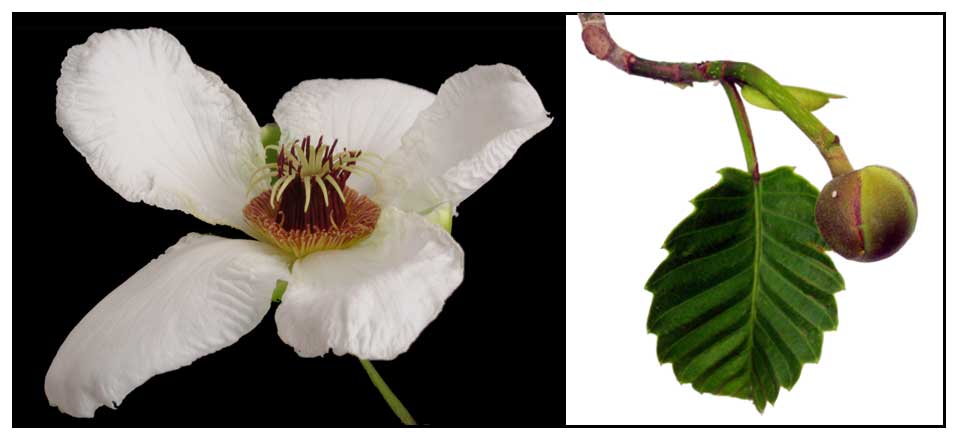Botany
Katmon is a tree reaching a height of 6 to 15 meters, smooth or nearly so. Leaves are leathery, shining, ovate, elliptic or oblong-ovate, 12 to 25 centimeters long, and coarsely toothed at the margins. Flowers are white, large, soft, fleshy, and green, 6 to 8 centimeters in diameter, with large fleshy sepals tightly enclosing the true fruit.
 Distribution Distribution
- According to Quisumbing's compilation, found only in the Philippines, in forests, at low and medium altitudes.
- Categorized as "Vulnerable" in IUCN Red of List of Threatened Species (Date assessed: 01/01/1998)
Constituents
- Study of air-dried leaves of Dillenia philippinensis yielded betulnic acid and 3-oxoolean-12-en-30-oic acid. (See study below) (1)
- Study of leaves yielded 11 compounds including one new sulfated glucoside and a new seco-A-ring oleanane-type triterpenoid. (See study below) (2)
- Air-dried leaves yielded betulinic acid.
Properties
- Leaves and bark are laxative and astringent.
- Studies suggest antimicrobial, anti-inflammatory, analgesic, antidiabetic, hypoglycemic properties.
Parts
utilized
- Fruit, leaves, bark.
 Uses Uses
Edibility
• Fruit contains a soft, fleshy, green and edible pulp, with the flavor of a green, sour apple.
• Used for making sauces and jams; also used for flavoring fish.
• Fruit when cooked, used as vegetable.
• Fruit used as base ingredient in an Instant sinigang powder mix. (see study below) (16)
Folkloric
• The acid juice of the fruit, mixed with sugar, is used for coughs.
• Fruit decoction used for cough and chest pains.
• Also employed for cleansing the hair.
• In Sabah, young leaves or stem bark pounded and applied as paste on swellings and wounds.
• Elsewhere, sugared fruit juice used as cooling beverage for fevers; also, as cardiotonic.
• Leaves and bark used as laxative and astringent.
Others
• Red dye: A red dye is obtained from the tree bark.
• Wood: Provides a useful timber. Used for posts, beams joists, rafters, flooring, sheathing and ceiling, furniture and cabinetry work, musical instruments, paving blocks, and mine timber.. (15)
Studies
• Antimicrobial Triterpenes / Leaves: Study of air-dried leaves of Dillenia philippinensis yielded betulnic acid and 3-oxoolean-12-en-30-oic acid. The two compounds exhibited moderate activity against fungus Candida albicans and slight antibacterial activity against E. coli, P. aeruginosa, S. aureus, and B. subtilis. Compound 2 showed slight activity against T. mentagrophytes. (1)
• Glucoside / Triterpenoid: Study of leaves yielded 11 compounds including one new sulfated glucoside and a new seco-A-ring oleanane-type triterpenoid. Anti-leishmanial and cytotoxic activity against A549 human lung adenocarcinoma cells were also examined. (2)
• Betulinic Acid / Hypoglycemic / Anti-Inflammatory / Analgesic / Antibacterial: Air-dried leaves yielded betulinic acid. Preliminary study in mice showed a hypoglycemic effect, an anti-inflammatory effect evidenced by inhibition of carrageenan-induced pleurisy, analgesic activity with antagonism of tail-flick and acetic-acid induced writhing responses, and dose-depended inhibition in abdominal constriction response. Betulinic acid also showed antibacterial activity against E. coli, P. aeruginosa, S. aureus, and B. subtilis and antifungal activity against C. albicans and T. mentagrophytes. (4)
• Antihyperglycemic / Leaves: Study evaluated crude leaf extracts for anti-hyperglycemic effects in mice. Phytochemical analysis yielded tannins and flavonoids. Results showed concentration dependent hypoglycemic effects. (5)
• Acute Toxicity Study / Anthocyanins and Polyphenols / Fruit: Study investigated the acute toxicity effects of fruit extract, anthocyanins and polyphenols from D. philippinensis fruits. Toxicological observations according to OECD guidelines showed toxicity at a single oral dose of anthocyanin and polyphenols at 5000 mg/kg. Signs of toxicity were decreased motor activity, poor startle reaction, excessive micturition, decreased respiratory depth and rate. At 5000 mg/kg dose, there was calcification along the focal tract and focal periportal necrosis in the liver. However, fruits showed to be safe when eaten as raw foods. A 300 mg/kg dose was recommended for daily intake. (6)
• Red Colorant from Bark: Study evaluated the red dye extracted from air-dried ground katmon bark as a safer and more compatible source for alternative to synthetic dyes like Allura Red in pharmaceutical syrup formulations. Many synthetic dyes have been reported to cause hazardous effects to humans and the environment. (7)
• Antioxidant / Fruits: Study evaluated the secondary metabolites and antioxidant activity of 31 edible wild fruits in the Benguet, Cordillera Administrative Region of the Philippines. The fruits yielded alkaloids, steroid glycosides, saponins, flavonoids, polyphenols, and tannins. The fruits yielded more polyphenols than flavonoids. Dillenia philippinensis exhibited the highest antioxidant activity. (8)
• Antioxidant / Fruit and Leaves: Study evaluated the antioxidant activity, total phenolic, flavonoids, and carotenoids from fruit and leaves of simpur pilipina. An ethyl acetate leaves extract showed the best DPPH scavenging activity with IC50 10.24 µg/mL and highest total phenolic content 33.564 mg GAE/100 mg extract. An n-hexane leaves extract showed the highest flavonoid and carotenoid content (10.905 mg QE mg extract and 6.579 mg BE/100 mg extract, respectively.) (9)
• Antidiabetic / Bark: In a study of three plants with claims for antidiabetic potential, Dillenia philippinensis bark showed effective lowering of blood glucose levels in alloxan induced diabetic mice. Blood glucose level lowered by 15.92% at 3o mins, 5.57% at 120 mins, and 12.43% at 24 hours post treatment. Results were comparable to glibenclamide. (11)
• Oleamide / Potential for Alzheimer's Disease: Crude hexane extracts of nine species of Dillenia, including Dillenia philippinensis, were studied for chemical contents via GC-MS, cytotoxicity and genotoxicity. Oleamide, a chemopreventive agent which acts against Alzheimer's disease, enhance memory function and promotes sleep, was found at highest amount (18.05-75.60%). Other components in high amounts were squalene and vitamin E. IC50x of all studied species was higher than 430 µg/mL. Comet assay indicated insignificant DNA damage (p>0.05). Results suggest nontoxicity to human cells and potential use for treatment of Alzheimer's disease and other related conditions. (12)
• Cytotoxic Activity Against Drug-Sensitive and MDR Cancer Cells / Leaves: Study evaluated the bioactivity of D. philippinensis and its potential use in cancer therapy. Dillenia philippinensis fraction (DPI) from a hexane partition exhibited cytotoxicity (IC50<30 µg/ml) against MCF7, HCT116, HCT-15 and HCT-15/Dox cells. The DP1 was able to inhibit P-glycoprotein (P-gp) activity in a dose-dependent manner, suggesting a role in targeting cancer cells with overexpressed P-gp. Results demonstrate potential chemotherapeutic properties and promise for future drug development against cancer. (13)
• Instant Sinigang Powder from Fruit: Study reports on the development of an instant sinigang powder using the Katmon fruit as the base ingredient and using solely the natural sour taste for sinigang dish. The product is shelf-stable and is comparable with other sinigang mixes that uses chemicals to enhance the sourness of the seasoning. (15)
Availability
Wild-crafted. |


![]()

